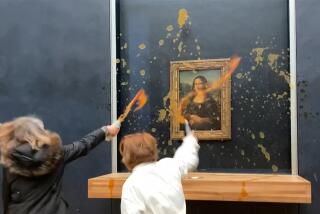BIRDS WITH A MESSAGE FLY TO FREEDOM
Shaw was releasing pigeons--hundreds of messenger pigeons, sprung Friday afternoon from cages on the steps of the Natural History Museum in Balboa Park. In a flash, they circled high and were out of sight, winging to a half-dozen loft points throughout the county. As a publicity stunt, it worked quite nicely, with reporters, photographers and a TV news crew intensely documenting the moment. For artist Cutler-Shaw, though, it was less a stunt than another spreading of “the message.”
If anything, Cutler-Shaw’s art doesn’t lend itself to facile publicizing. It’s a bit too complex, metaphysical and fragmentary for that, but this small, blonde La Jollan has a way of attracting attention. There’s her private art, a mixed media of text and drawing that explores, in her words, “the point where fact and metaphor intersect.” And there’s her public arts activism, best exemplified by her leadership of the Landmark Art Project, which addresses environmental issues through art, and the Landmark Art Collaborative, which unites visual artists with landscape architects for local projects.
Friday’s pigeon release was keyed to Cutler-Shaw’s ongoing exhibit at the museum, “Wingtrace/The Sign of Its Track,” which runs through Jan. 27. The display mixes a series of 50 drawings--her “Alphabet of Bones”--that create a unique calligraphy from the hollow bones of messenger pigeons; a series of horizontal scrolls that depict the evolution of the messenger bird; vertical scrolls that include the artist’s lengthy poem, “How Many Wing Beats From Beirut to the Jewel of the Sea,” and a “Wingwall” of 50 overlapping paper wing collages.
“My art relates to word as image, and the issue of survival,” said Cutler-Shaw. “My concept is of the artist as a messenger of hidden events, of very private, personal meanings, as a medium for communicating. It’s a matter of finding a visual language to represent things in the world that can move others, that have a universal meaning.”
Cutler-Shaw’s “Odyssey of the Messenger” series--of which “Wingtrace” is a part--has been in progress for a decade, ever since she seized on the messenger bird as a central image. Before that, her major work had been a “Name Wall” at the Los Angeles International Airport, for which she titled thousands of wall tiles along the airport’s long passageways with first names--a means, she explained, “of transforming and personalizing a very depersonalized public space. In a way, that’s what the whole messenger series is also about--an immediate human connection.”
A native New Yorker, Cutler-Shaw’s connection to San Diego began in 1959 when she and her businessman husband relocated here. An English major at Columbia University, Cutler-Shaw did graduate study at UC San Diego and gradually moved toward drawing and mixed-media work as the ‘60s wore on.
“I needed to find a form,” she recalled. “There was no way that painting on a canvas could encompass the kind of things I was trying to communicate. I needed a public forum, and fortunately the whole movement in art, and the woman’s movement, were pivotal for me.
“But California was the most pivotal--there was the sense you could come out here and everything is possible, you can do almost anything. And I did. My intermedia work in the ‘60s used text and writing and painting, but I needed a central theme. When I discovered the bird, it seemed inevitable.”
So Cutler-Shaw has not only incorporated bird imagery into her work, but turned the mass releases of messenger pigeons into a sort of trademark for the opening of her exhibits, public projects and readings. In 1982, pigeons heralded the Landmark Art Projects’ “Waters of the Nations/Messages From the World” at the United Nations Plaza in New York, at which a word sculpture of ice--the word was “survival”--was formed from the commingled waters of 90 nations.
Locally, the Landmark Arts Collaborative is seeking funds for such innovative projects as an “Urban Mesa,” a downtown re-creation of a geological stratum, and a “Museum of Seasonal Change,” a three-acre forest with a central square as arena for seasonal installations and individual artists’ performances. Already, notes Cutler-Shaw, the Collaborative has given San Diego an “Urban Meadow,” a non-irrigated self-reseeding planting of wildflowers composed in various patterns at the northeast edge of Balboa Park. Plans also call for an “Urban Meadow II.”
“I can see the next five years of work spread out before me,” mused Cutler-Shaw. “Extensions of the message monuments, messages from the borders of the world, several installations in public buildings. But it’s all really one message--about the contradictions of human experience: we are free but we are caged like prisoners at the same time. And we are realizing there is never a simple, single message at all. That’s not what life is like.”
More to Read
The biggest entertainment stories
Get our big stories about Hollywood, film, television, music, arts, culture and more right in your inbox as soon as they publish.
You may occasionally receive promotional content from the Los Angeles Times.










